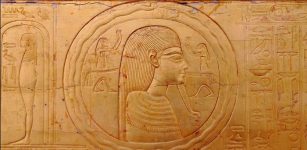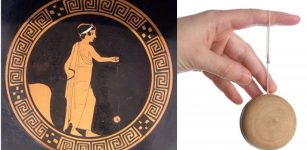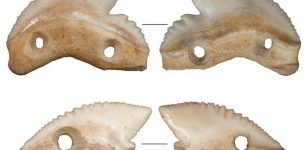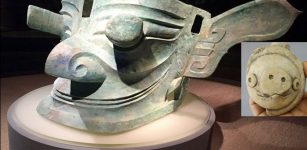Miniature Magical Stela Of God Horus-Child Standing On Crocodiles Protected Against Wild And Poisonous Creatures
A. Sutherland - AncientPages.com - The place of origin of this miniature basalt stela is unknown.
This type of amulet as a 'stela' was prevalent in the late and Ptolemaic-Roman periods. It was used as amulets, healing and protecting properties against wild animals and other harmful creatures.
 A Stela of Horus-Child standing on crossed crocodiles. Image credit: H.S.K.Bakry
A Stela of Horus-Child standing on crossed crocodiles. Image credit: H.S.K.Bakry
In ancient Egyptian myths, the goddess Isis raised his child Horus and had to hide in the marshes from his enemy, Seth.
Cippi (magical stelae) represent Horus's healing from poisonous scorpion stings and snakebites in the marshes. Egyptians believed a liquid poured over a magical stela could absorb and transfer the power of the stela's spells and images to the worshipper.
They appeared in Egypt during the 18th Dynasty (ca. 1550-1295 BC) and were continuously used until the Roman Period.
Miniature basalt stela showing Horus-the-child is an example of this kind of art, generally known as 'Horus cippi' (Horus Stelae). On its front side is a depiction of the god Horus as a child standing on the backs of two crossed crocodiles.
The god Bes-mask is above Horus' head, which is badly damaged on this particular stela. In his right hand, he holds two serpents, a scorpion and an antelope. In his left hand are two snakes, a scorpion and a lion. All these figures are carved in bas-relief.
 Cippus of Horus on the Crocodiles, 3rd century B.C.E. Steatite, 9 1/8 x 5 5/16 x 2 3/16 in. (23.2 x 13.5 x 5.6 cm). Brooklyn Museum
Cippus of Horus on the Crocodiles, 3rd century B.C.E. Steatite, 9 1/8 x 5 5/16 x 2 3/16 in. (23.2 x 13.5 x 5.6 cm). Brooklyn Museum
On the stela's right side, we recognize the falcon of Horus standing on a papyrus flower: the falcon is wearing a two-feathered crown and on the left is a papyrus plant surmounted by a double plume.
The amulet's front side is also decorated with demons, deities, and magical figures. The reverse side of the stela is covered with four columns of incised hieroglyphic inscription.
Most Horus stelae are portable amulets. This stela-amulet is very small (h: 8.7 cm, w: 5.1 cm, d: 2.3 cm), but many others were available in various sizes.
Archaeologists discovered hundreds of similar examples of Horus stelae, made of various materials including stone, marble, wood, and faience. Inscribed with magical or /and religious text, they vary in size.
Written by - A. Sutherland - AncientPages.com Senior Staff Writer
Copyright © AncientPages.com All rights reserved. This material may not be published, broadcast, rewritten or redistributed in whole or part without the express written permission of AncientPages.com
Expand for referencesReferences:
Draycott J. Size matters: Reconsidering Horus on the crocodiles in miniature
Bakry, H. S. K. "A STELA OF HORUS STANDING ON CROCODILES FROM THE MIDDLE DELTA." Rivista Degli Studi Orientali 42, no. 1 (1967): 15-18.
More From Ancient Pages
-
 Mysterious Hakkari Stelae: Were They Carved By Inhabitants Of Ancient Kingdom Of Hubushkia?
Artifacts | Nov 15, 2018
Mysterious Hakkari Stelae: Were They Carved By Inhabitants Of Ancient Kingdom Of Hubushkia?
Artifacts | Nov 15, 2018 -
 Mystery Of The Candelabrum: One Of The Most Enigmatic Ancient Giant Ground Drawings In The World
Featured Stories | Nov 2, 2015
Mystery Of The Candelabrum: One Of The Most Enigmatic Ancient Giant Ground Drawings In The World
Featured Stories | Nov 2, 2015 -
 Historian Suggests Jack The Ripper Fled To Australia Where He Met His End
Archaeology | Sep 10, 2016
Historian Suggests Jack The Ripper Fled To Australia Where He Met His End
Archaeology | Sep 10, 2016 -
 8,000-Year-Old T-Shaped, Four-Sided Structure With Pyramidion – Uncovered in Turkey
Archaeology | Nov 23, 2019
8,000-Year-Old T-Shaped, Four-Sided Structure With Pyramidion – Uncovered in Turkey
Archaeology | Nov 23, 2019 -
 New System Will Give Stone Age Skeletons And Mummies Unique Names
Archaeology | Oct 2, 2024
New System Will Give Stone Age Skeletons And Mummies Unique Names
Archaeology | Oct 2, 2024 -
 On This Day In History: Spanish Conquistadors Led By Hernan Cortés Entered The Aztecs Capital Tenochtitlán – On Nov 8, 1519
News | Nov 8, 2016
On This Day In History: Spanish Conquistadors Led By Hernan Cortés Entered The Aztecs Capital Tenochtitlán – On Nov 8, 1519
News | Nov 8, 2016 -
 Porobonus – Mysterious Unknown Pagan God
Artifacts | Aug 28, 2015
Porobonus – Mysterious Unknown Pagan God
Artifacts | Aug 28, 2015 -
 Scathach – The Shadowy One – Legendary Martial Arts Teacher Who Trained Cuchulainn And Other Warriors
Featured Stories | Mar 4, 2019
Scathach – The Shadowy One – Legendary Martial Arts Teacher Who Trained Cuchulainn And Other Warriors
Featured Stories | Mar 4, 2019 -
 Ouroboros: Ancient Infinity Symbol Used By Different Ancient Civilizations
Ancient Symbols | Oct 3, 2017
Ouroboros: Ancient Infinity Symbol Used By Different Ancient Civilizations
Ancient Symbols | Oct 3, 2017 -
 There Is A Problem With The Footprints Claimed As Evidence Of Ice Age Humans In North America – Scientists Say
Archaeology | Nov 16, 2022
There Is A Problem With The Footprints Claimed As Evidence Of Ice Age Humans In North America – Scientists Say
Archaeology | Nov 16, 2022 -
 Oldest Case Of A Rare Genetic Condition Discovered
Archaeology | Aug 27, 2022
Oldest Case Of A Rare Genetic Condition Discovered
Archaeology | Aug 27, 2022 -
 During Tough Times Ancient ‘Tourists’ Sought Solace In Florida Oyster Feasts
Archaeology | May 4, 2020
During Tough Times Ancient ‘Tourists’ Sought Solace In Florida Oyster Feasts
Archaeology | May 4, 2020 -
 Oldest Yo-Yo Dates Back To 400-500 B.C
Ancient History Facts | May 13, 2019
Oldest Yo-Yo Dates Back To 400-500 B.C
Ancient History Facts | May 13, 2019 -
 Giant Bath Tub Built For Tsar Alexander I – Why Was It So Large?
Featured Stories | Jul 11, 2018
Giant Bath Tub Built For Tsar Alexander I – Why Was It So Large?
Featured Stories | Jul 11, 2018 -
 10,000 Years Ago Cattle Was Domesticated In The Central Nile Region – New Study
Archaeology | May 23, 2022
10,000 Years Ago Cattle Was Domesticated In The Central Nile Region – New Study
Archaeology | May 23, 2022 -
 7,000-Year-Old Shark-Tooth Knives Discovered In Indonesia
Archaeology | Oct 27, 2023
7,000-Year-Old Shark-Tooth Knives Discovered In Indonesia
Archaeology | Oct 27, 2023 -
 Unsolved Enigma Of The Inga Stone And Its Mysterious Ancient Undeciphered Signs
Artifacts | Jan 18, 2015
Unsolved Enigma Of The Inga Stone And Its Mysterious Ancient Undeciphered Signs
Artifacts | Jan 18, 2015 -
 Old Clay Pig Figurine And A 5,000-Year-Old Settlement Found Near Mysterious Sanxingdui Ruins, China
Archaeology | Jul 30, 2020
Old Clay Pig Figurine And A 5,000-Year-Old Settlement Found Near Mysterious Sanxingdui Ruins, China
Archaeology | Jul 30, 2020 -
 Lady SAS – Ancient Skeleton Of Foreign Woman Found In Palenque – Who Was She?
Archaeology | Apr 11, 2023
Lady SAS – Ancient Skeleton Of Foreign Woman Found In Palenque – Who Was She?
Archaeology | Apr 11, 2023 -
 On This Day In History: Independence Of Greece Is Recognized By The Treaty Of London – On May 7, 1832
News | May 7, 2016
On This Day In History: Independence Of Greece Is Recognized By The Treaty Of London – On May 7, 1832
News | May 7, 2016
